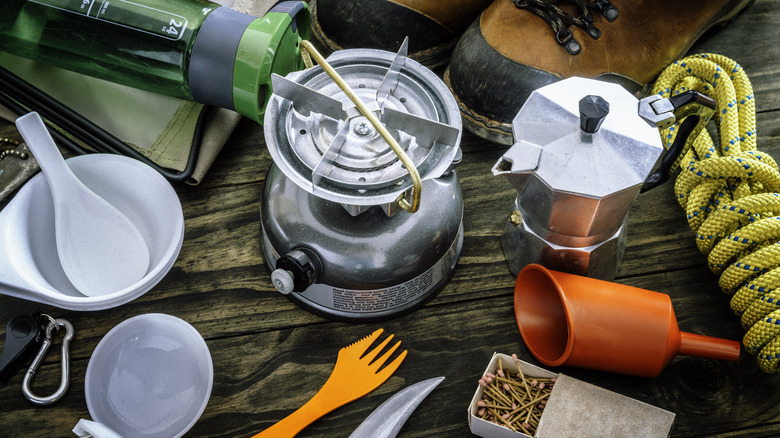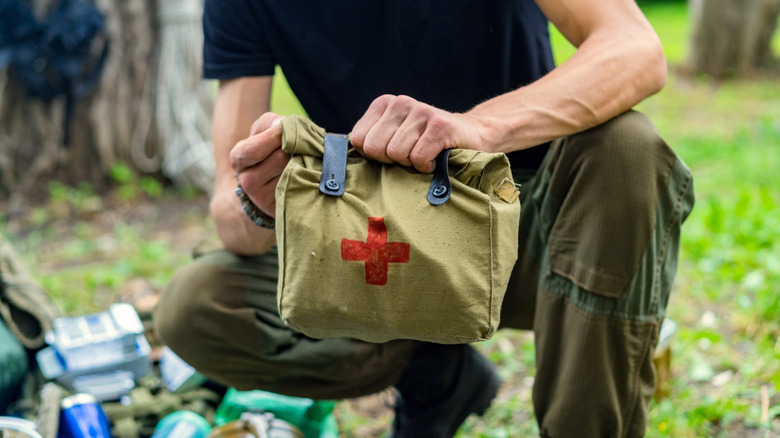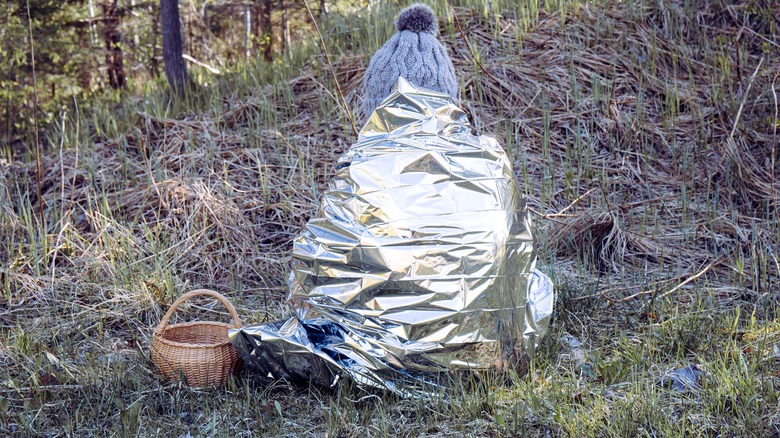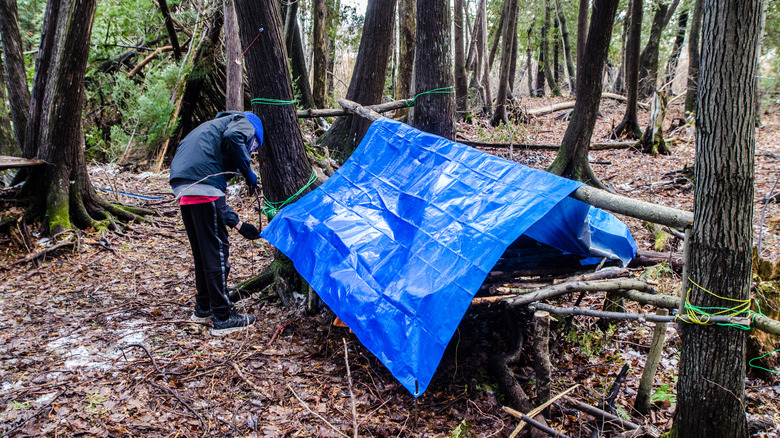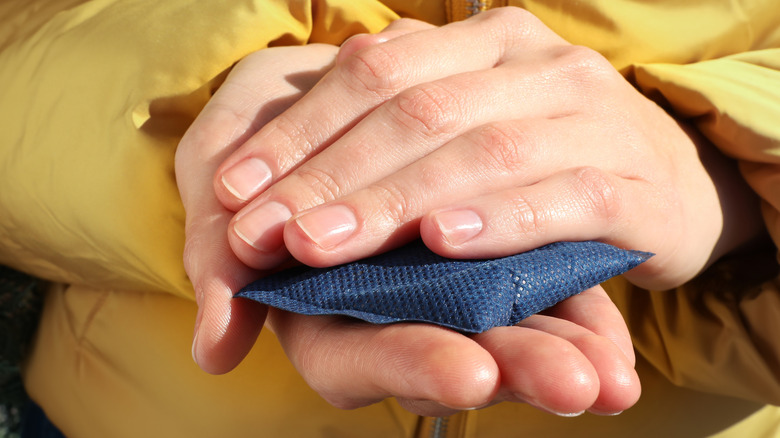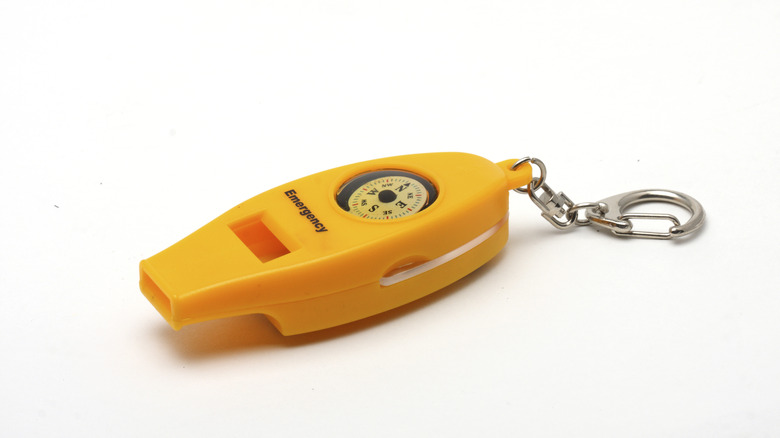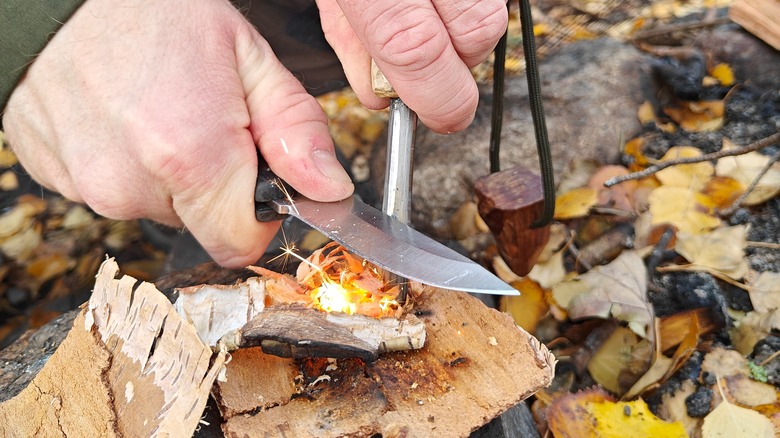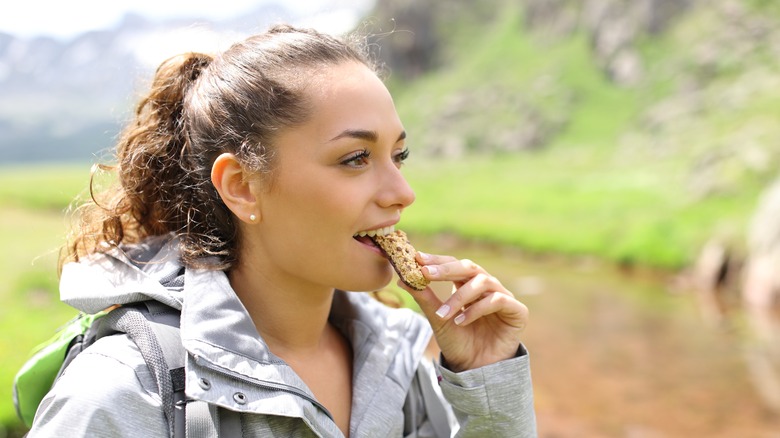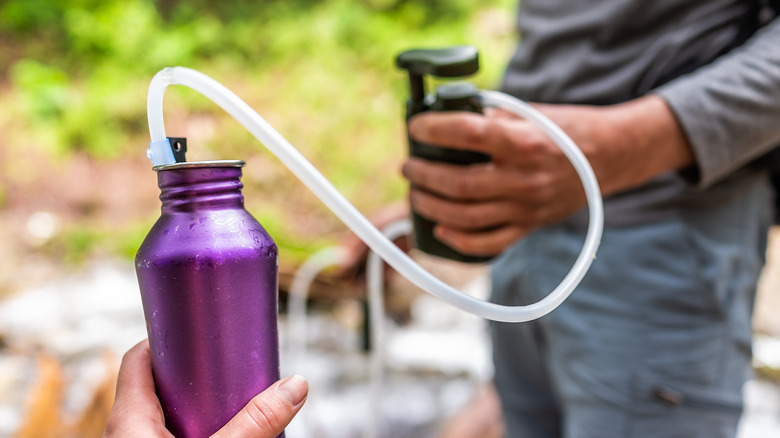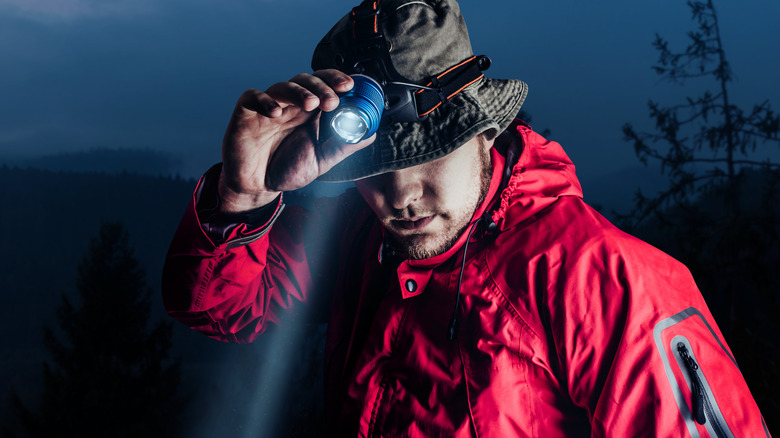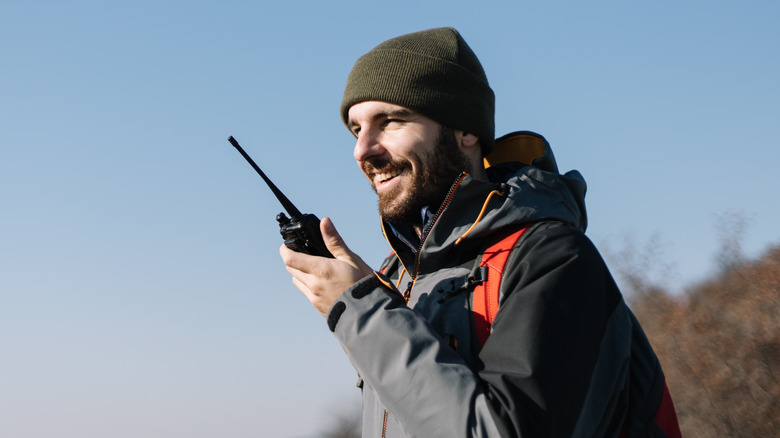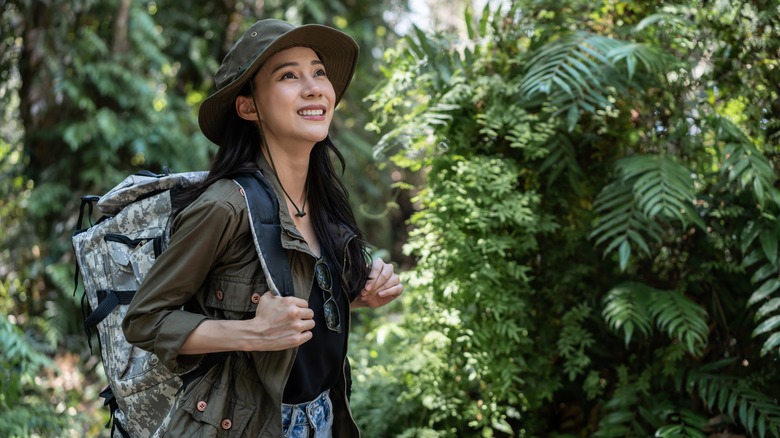These Emergency Supplies Could Save Your Life When Camping
Camping is usually a pleasant activity. Sure, there are some annoying things campers do, and certain rules need to be followed, but overall, a week or weekend away in the woods can be just what the doctor ordered. However, some camping trips don't go as planned and may send you to the doctor's office for all the wrong reasons.
There are times when camping just goes wrong. Times when one finds themselves in a real pickle and is at a loss for what to do. These camping emergencies could end up costing someone their life if the proper precautions are not taken. One of those precautions is to avoid common packing mistakes and have a set of emergency supplies with you. Some companies sell pre-packed emergency camping kits. However, to make the experience more personalized, it might be better for you to make an emergency kit tailored to your specific needs. If that is the route you choose to go, here are the 13 essential emergency supplies that can be a life-saver during your camping trip.
First aid kit
First aid is mandatory for camping. Whether you're treating cuts and bruises or tending to something more serious like deep lacerations, broken bones, or bites from ticks or snakes, having a first aid kit ready to go will only aid you in the long run. Having a well-stocked first aid kit could make the difference between life and death in camping or backpacking emergencies.
But what does well-stocked mean? Obviously, campers will not be carrying an entire operating room's worth of medical gear with them any time they go out. But a good first aid kit is one that has all of the essential tools you need to temporarily treat any wounds you might receive while you're out camping. The must-haves are bandages, gauze, medical tape, disinfectant wipes, ibuprofen, iodine, splints, hand sanitizer, antihistamines, tweezers, and a first-aid instruction manual.
This is–by no means–the only medical gear you should have in your kit, but they are a great place to start. The goal of first aid in the wilderness is to treat the wound to such a degree that, by the time the professionals arrive, it hasn't gotten any worse. For this reason, enrolling in first aid training at your local YMCA or Red Cross may also be worthwhile.
Emergency thermal blanket
Having extra layers of clothing is one of the primary rules of camping or backpacking. Though great for regulating body temperature, layers are only going to get you so far. It is always better to have something extra that you can turn to, especially if you are not able to maintain a fire. This is where the emergency thermal blanket comes in.
An emergency thermal blanket must be on your list of first-aid essentials to pack, but we singled it out for its multiple uses. While it does help reflect body heat back on someone who is suffering an injury, having an emergency thermal blanket will help keep you warm even if you aren't injured. This is especially important if you're caught in nasty weather like a snowstorm while camping. Hypothermia is a very real condition that could lead to death in as little as an hour in extremely cold temperatures.
The great thing about emergency thermal blankets is that they are easy to store. Because they are made with thin reflective lining, they fold up slimy and can easily fit in a backpack or gear case without adding any weight. If you find yourself in need of one, cover as much of your body as you can with it. The more heat you retain, the better.
Vinyl tarp and rope
Getting stuck in a storm while you're headed back to your tent is never fun. What makes things worse is if that storm leaves you stranded or is too intense to continue on through. It's times like these when looking for shelter is going to be extremely stressful. So, it's always a good thing to have a vinyl tarp and rope handy. With both, you can have a halfway decent shelter ready within a few minutes.
When selecting your tarp and rope, you want them to be compact enough to fit into a backpack. However, they should also be large and long enough to cover you and stabilize your shelter. An 8x10-foot tarp should provide enough protection for at least two people. Aim to have 50 to 100 feet of rescue paracord rope because you will run out faster than you think.
If you don't plan on leaving your campsite for any reason, it's still a good idea to keep a tarp and rope at the ready. Your tent could collapse due to weather, or the roof in your camper might spring a leak. While both can be fixed, no doubt, at the moment they occur, it is great to have a tarp ready to place over it and keep you dry.
Hand and toe warmers
Having hand warmers to keep your outer appendages in working order is paramount. Being able to use your hands is vital to your survival. Cold, numb hands can easily make mistakes, which could end up causing more issues. Hand warmers are a great tool because they pack easily, so you can bring a lot of them. Toe warmers are needed, too, because no one wants cold feet.
Quality toe and hand warmers tend to last 7 and 12 hours, respectively. This means that if you pack ten hand warmers, you have around five days' worth of finger warmth for yourself. Plus, the great thing about hand and toe warmers is that all you need to do is expose them to oxygen, and they will begin working. This is because warmers are made with everyday ingredients like iron, salt, and carbon. They're non-toxic and will provide the heat necessary for your joints to stay functioning.
You don't just need hand and toe warmers for cold fall or winter camping. For example, if you get lost in the desert and need to set up an emergency camp for the night, you'll likely run up against some really cold temperatures. In this scenario, having the warming packs will only benefit you in the long run, regardless of the season.
Survival whistle
It may seem silly, but having a survival whistle is one of the best ways to keep you alive in the wilderness. Another one of those easy-to-pack essentials–that won't add any unnecessary weight–is survival whistles, which are actually more than what they seem on the surface. There are some that come with multiple functions, including the whistle itself, a waterproof match container, a compass, a signal mirror, and a flint fire starter.
The main tool, however, is the shrill rescue whistle. The sound this makes is important because it does not replicate anything found in nature. So, if you blast out some signals to a rescue team, they can pinpoint your location with better accuracy because they are not going to confuse the sound for that of an animal.
There are plenty of ways to make your presence known to rescue teams in the area. Many of them, like smoke signals, SOS signs, or GPS beacons, take a lot of time and effort to construct or get to work right. With a survival whistle, all you need to do is blow. Any trained rescuer will be able to find you simply by hearing your whistle.
Map and compass
While they are great tools, you cannot rely on your GPS or the maps on your phone to get you out of a sticky situation in the wilderness. Batteries die, and signals will be lost, which is why having a physical map and compass is a no-brainer.
Being able to read and understand maps and compasses is of vital importance for any camper. For beginners, it is a simple matter of learning what the symbols and directions mean on both. Once you've mastered the basics, you should have a pretty good idea of how to locate your position on a map and which direction you should head if you want to make it home.
This isn't reserved for hiking, however. Let's say that you're driving to your campsite, and the main road is blocked. You have no signal for either your phone or GPS. Having a map and compass handy is going to help you find an alternative route, especially if the highway crews have yet to map out a detour. Whichever way you swing it, maps and compasses are essential tools that no camper should be without.
Multitool
What would MacGyver be without his Swiss Army knife? It was his go-to for getting him out of countless scrapes and emergency situations. While not everyone may be setting out on globe-trekking secret adventures, having a multitool with you when you go camping is always a good idea.
One key to packing for camping is to pack light. Having multiple tools in one will keep the bulk down while also minimizing weight. Most multitools will come equipped with basic needs like a main blade, pliers, and screwdriver. Others will include extras, like corkscrews, can openers, tweezers, flints, and toothpicks. All can be used in emergency situations.
Here are a few things you can do with a multitool: Process food from a hunt, make a spear, process tinder to start a fire, cut bandages for first aid, saw twigs for kindling, open jars of food–we could go on! These examples are just the start of what could end up being a very long list of everything you could do with a multitool. Let's just say you need one and leave it at that.
Fire starter kit
Fire is an important component for survival in any emergency camping situation. You need reliable ways of making a fire; otherwise, you are literally going to be left out in the cold. Matches are excellent to have on hand. They store easily, and you can even buy ones that are wind- and rain-resistant. However, they are not always reliable, and there is a chance you will run out of them during the length of your survival situation.
The best way to make sure you can stay warm in any emergency situation is to have a fire starter kit that contains a strike, flint, and tinder. These will come in waterproof containers, and once you get the hang of it, they will be much more effective than using a match. Having dry tinder is especially helpful if you're unable to find dry twigs to burn to get the fire going.
Again, as with other tools on this list, you can very easily store your fire starters inside your backpack. A small hatchet would also not be out of place as a fire-starting aid. However, if you have a multitool, you'll find it's handy enough to help you collect the wood you need.
Nonperishable food
Even if you don't find yourself in any kind of camping emergency, having some easy-made-ahead meals or nonperishable food on hand is a good idea. It is advisable to have at least three days' worth of nonperishable food in case of an emergency. If you're stranded for an extended period of time, rationing is key to making sure you have enough nutrients to fuel your body.
When it comes to nonperishable items, canned food is going to be your most practical option. Though it's not totally necessary, ensuring you have a can opener on your multitool and a way to heat up the food will improve your eating experience immensely. Other options include jerky, trail mix, mixed nuts, chocolate, granola, and dried fruit.
Freeze-dried food is also an option, but here, you run into a bit of a quagmire. Whenever anything is freeze-dried, except perhaps fruit, you need to rehydrate it in order to cook it. Most people will bring camp stoves and water with them, but that water ought to be going towards your rehydration, not food.
Extra water or water filter
Speaking of water, you always want to make sure you have the means to either procure some more or have stores of it on hand. This is possible for both camping and backpacking situations, though the processes look a little different. For camping, it is possible for you to bring and store several gallons of water in a car or cooler. If you already pack bottled water, you are less likely to have to source it from potentially hazardous areas.
If you're backpacking, however, you can't be lugging around gallons upon gallons of water. Instead, those who are serious about backpacking need to invest in other ways to purify their water, such as iodine tablets, a portable filtration system like a LifeStraw, or a jet boiler. All are effective ways for backpackers caught in a situation to get drinking water. Of course, boiling water is going to be the most effective way to destroy any potential contaminants, which is why it is so important to have a camp stove with you at all times or some means to make a fire.
Headlamp or lantern
Extra light will always be helpful in any kind of emergency camping situation. Whether in the portable form of a headlamp or the more stationary form of a lantern, the light that shines from these tools is going to help you see what you're doing in the dark. While we would never advise trying to navigate at night, having a headlamp will make the process easier. Use lanterns for when you are tending to things around camp.
As such, it is always a good idea to pack extra batteries for your headlamps or lanterns. With extended use, chances are they will likely die or dim so low that they aren't remotely helpful anymore. Having the correct batteries, AA or AAA for headlamps and C for lanterns will keep your light systems operational.
Hand crank lanterns are another excellent tool because they negate the need for extra batteries. The battery in the crank lantern charges via a spin wheel that operates similarly to winding a clock. Wind the lantern up, and it will run for you–no extra batteries required.
Walkie talkies
Having a good set of walkie-talkies, or hand radios as they are sometimes referred to, will be your best method of communication in an outdoor emergency. There is no better tool for connecting with people from a distance. Depending on the strength of your walkie-talkie's signal, you could pick up on multiple different channels, one of which might just get you saved.
Most modern walkie-talkies have a longer range and better battery life than any mobile phone. As such, you can count on them to be much more reliable in connecting you with the people you need. Many also come equipped with an emergency blast signal, which will send out an alert to any paired radios. Some walkie-talkies also come with flashing lights to help make locating you all the easier. Like with headlamps and lanterns, keep some extra batteries on hand in case yours run out. While the battery life will depend on the frequency with which you use the hand radio, having some as a backup is always a good idea.
Backpack
None of these emergency supplies are going to do you any good if you don't have a place to store them. What you need is a backpack to keep all these items organized. It doesn't have to be a full-blown hiking backpack, but a decent-sized day pack with plenty of room for your water, first aid, headlamps, and other tools will come in handy.
You should be in the habit of bringing this pack with you whenever you leave camp. In the case that you cannot make it back for whatever reason, having all of your tools safe and available in one place is going to be a great asset to you. Storage organization is obviously the most important thing for backpackers. Store your emergency supplies in the top portion of your pack or the outer pockets so you can reach them easily.
Nearly every emergency can be lessened in severity if you just take the time to prepare these essential tools. There are other things that you could bring, but these 13 will be the ones to help save your life and get you back home in one piece.
